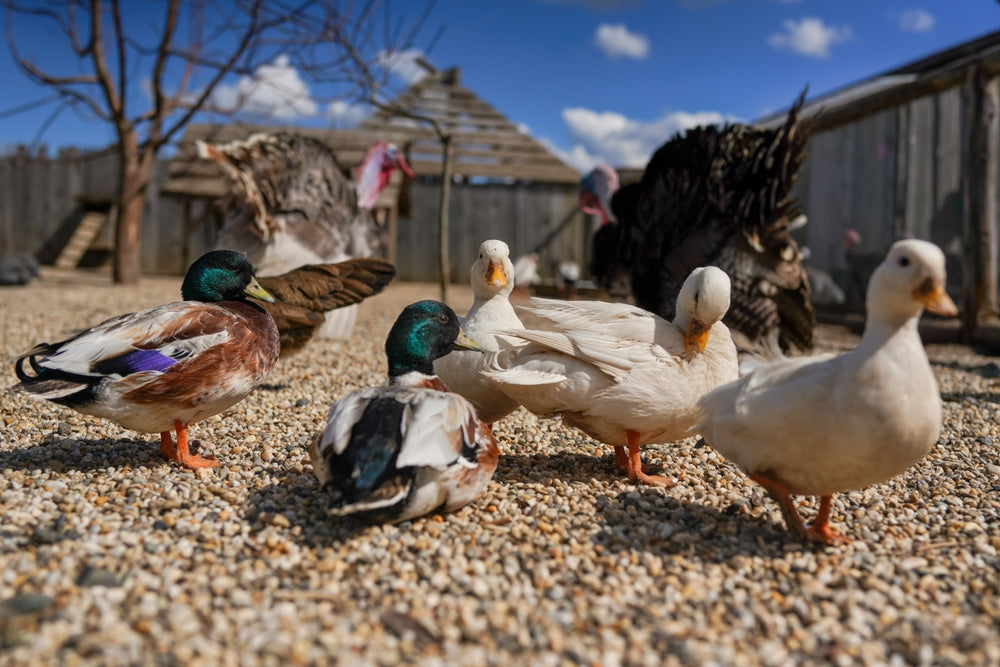
How much yard space do pet ducks need?
Has your passion for birds migrated to ducks? Excellent! If you're adding a few quackers to the yard, you might wonder what types of shelter, fencing and special supplies your waterfowl need. While considering the nuts and bolts, you also want to answer the ultimate duck question, "How much room do ducks need to be cozy and happy?" After all, they are one of our favorite feathered friends.

In short: Ducks need space to roam, swim and hunker down for the night. Here's how to set up the perfect duck oasis before bringing home a few White Pekins, Mallards, Silver Appleyards or Saxonies.
Let Your Ducks Roam Free
Janet Garman from Timber Creek Farm holds a degree in large animal farm management and animal science from the University of Maryland. She raises ducks on her farm for reliable egg laying and to keep grubs and snails to a minimum on her land.
She says ducks prefer to have the run of your property during the daytime, but if they need to be contained by a fence for safety, be sure you give them a large space to allow for foraging in weeds and grass and dining on insects. Some duck enthusiasts will add a large fenced pen around their duck shelter (more on that shortly!), so the pets can come and go as they please.
A good rule of thumb is to have about 16 square feet of outdoor roaming area and 4 to 6 square feet of ground space in a shelter for each pet duck. If you plan to keep your ducks indoors during the winter, plan for 25 square feet of space per pet.
Create a Space for Swimming
Ducks love to swim and preen their feather in the water. So, be sure you create a space for these activities! This might be giving the ducks access to a farm or ornamental garden pond, a children's small wading pool or even a pet pool.
Note: Ducks like to get a bit messy, and their swimming space will get muddy. Don't plan on letting your toddler frolic in the wading pool later unless you're OK with mudpies!
What about on winter days when it's too cold to swim? Your pet ducks would love a shallow tub of warm water to play in for a few minutes several times each week. A child's wading pool or pet pool with a drainage opening for easy cleaning and ice melt runoff is best in colder climates.
House Outdoor Pet Ducks
Pet ducks also require clean, dry shelter with ventilation. This shelter is where they can safely rest from predators in the evening, preen their feathers and stay warm. Consider using a coop, garage, barn or shed.
The ideal shelter will have a natural light source (windows, skylight, door, etc.) to keep the pets happy and in tune with day/night cycles. Ample stimulation from daylight is especially important for egg layers.
Inside the shelter, the ducks need clean water just for drinking — not swimming. Consider using a waterer, like the K&H Duck Waterer, which holds up to 2.5 gallons of water and is available in heated and unheated models.
Ducks crave water and need to be able to dunk their entire bill into fresh drinking water daily. This waterer is designed for beaks and bills (and discourages perching). Consider the heated waterer option if you live in a climate with winters that drop below freezing. Or, opt for the K&H Universal Waterer Deicer. Place it under any existing waterer to keep drinking water thawed in cold weather.
Of course, ensure the ducks have access to food in their shelter overnight or during adverse weather.
And when it comes to accessories, unlike chickens, ducks don't need perches or nesting boxes. Instead, give ducks some loose straw to swirl into cozy nesting spots on the floor.
Finally, ducks enjoy warmth. Plug in a K&H Thermo-Chicken Heated Pad to keep chilly duck feet warm. When you keep a duck's feet warm, that heat circulates throughout their body. So, keep a duck's feet warm, and you'll keep their whole body warm — all winter long.
Place the heated pad on the shelter floor in an open area where the ducks can move freely off and on the pad to regulate their body temperatures. Or, you could hang it on the wall where the ducks like to nest and will come in contact with the pad by leaning.
All of this — roaming space, swimming areas and a stable shelter — does add up to dedicating ample backyard space to your duck friends. But it's totally worth it to see their comical waddles each day!
Learn more about caring for your pet ducks in "What temperature is too cold for ducks?"



